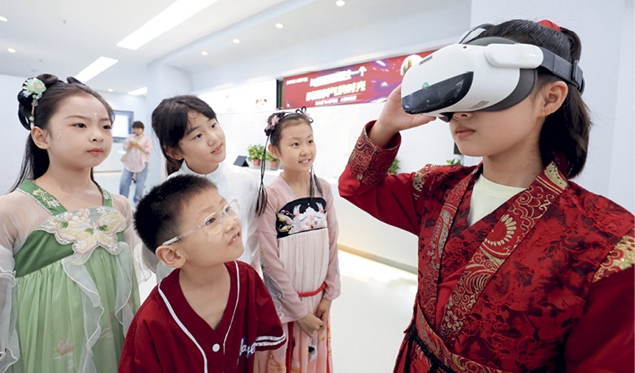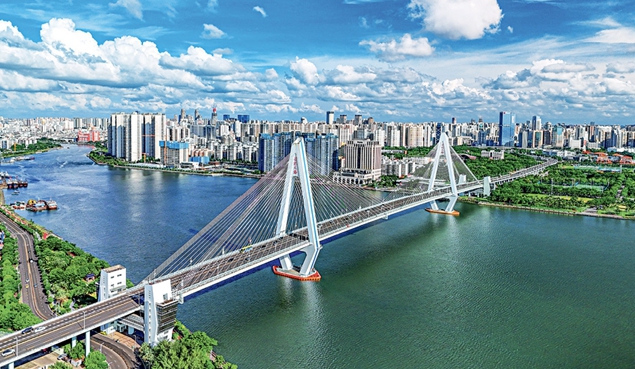A bridge spanning the Haidian River in Haikou, Hainan, June 23, 2024
In June 2023, Volume IV of Xi Jinping: The Governance of China was published in multiple languages in Beijing. Recently, I received the French version and immediately immersed myself in reading it. I wanted to make some comments, especially on Chapter 9, “Deepening Reform and Opening Up.” In a speech on September 1, 2020, titled “Focusing Reform on Creating a New Development Environment,” Xi Jinping stated: “We must continue to make the most of reform as a decisive measure, maintain our strategic determination to forge ahead despite all odds, deepen reform and practice higher-level opening-up, focusing on maintaining and perfecting socialism with Chinese characteristics, and modernizing the state governance system and capacity, so as to give strong impetus to creating a new development environment.”
The process of socialist modernization, initiated under the leadership of Deng Xiaoping nearly fifty years ago, continues to provide the guiding principle for the development policy pursued by the Communist Party of China (CPC). This strategic orientation was confirmed again very recently. From July 15 to 18, 2024, the Third Plenary Session of the 20th CPC Central Committee was held in Beijing. As stated in the final communiqué, “the Plenary Session welcomed the great achievements made since the new era in our efforts to comprehensively deepen reform,” and considered that “it is within the framework of reform and opening up that China’s modernization is advancing.”

A villager picks soilless vegetables at a modern greenhouse in Dalin Village, Youyang Tujia and Miao Autonomous County, Chongqing, July 3, 2024.
Originally, this historic change of direction was aimed at accelerating the “Four Modernizations” defined in 1964 by Zhou Enlai: modernizing industry, agriculture, science and technology, as well as the defense apparatus. But with Deng Xiaoping, the resolute opening of China to international flows became the pivot of economic reforms. For the inspirers of this strategy, the conquest of foreign markets was to be the engine of economic growth, while foreign investments would bring the productive apparatus the necessary capital and technologies. With reform and opening, China’s integration into the world economy has given a tremendous boost to the country’s development. Fifty years later, China has become the leading industrial and commercial power on the planet.
By emphasizing “strategic autonomy”, since 2012, Xi Jinping has resolutely pursued this movement: the internationalization of trade must serve the development of the productive apparatus. But this opening does not mean abandoning the “socialist path”, and the paradigm shift is not a change of system. The liberalization of the economy and opening up to international trade, in fact, are part of a carefully considered political strategy. It is about raising external capital and capturing modern technologies in order to build “a powerful and prosperous socialist country”. Making way for the market economy is therefore a means, not an end. It is a strategic choice intended to facilitate the transition from an administered economy to a mixed economy.
If China has chosen to accelerate its development through foreign trade, it is not to serve as a labor reserve for foreign multinationals. China’s ambition is to acquire the most innovative know-how to strengthen its strategic autonomy.
In 1995, the government issued a guide that categorizes foreign direct investment (FDI) into four categories: encouraged, permitted, restricted, and prohibited. FDI in the first two categories includes those that induce technology transfer, boost exports, rationally utilize local resources, and modernize the western and central regions. This strategy of controlled opening-up has been successful: between 1992 and 2023, Chinese exports increased 40-fold. In thirty years, China has become a key player in world trade, being today the world’s largest exporter and the largest trading partner of 130 countries.
China’s opening up to foreign investment, after thirty years of isolation, marked a break with the previous period. Carried out in stages and leaving room for local experimentation, this planned opening up of the Chinese economy has borne fruit. The CCP has succeeded in its modernizing gamble: FDI has increased from an average of 2.2 billion dollars per year between 1978 and 1989 to 30.8 billion between 1992 and 2000. Guided by a strategic State, international openness has boosted the economic activity of the entire country and helped to modernize the productive apparatus. Promoting technology transfers, the development of foreign trade is spectacular: between 1978 and 2006, the share of imports of goods and services in GDP increased from 5% to 28.5%, that of exports from 4.6% to 36%, making China a large economy open to the world.

A girl experiences immersive reading with a VR headset at the Huaibei Municipal Library in Huaibei, Anhui, July 19, 2024.
However, learning from the financial crisis triggered in the United States in 2008 and its catastrophic consequences for the global economy, the Chinese state is pursuing a proactive industrial policy, strengthening the domestic market and promoting the accelerated development of its western regions through massive investments in public infrastructure. Adopted in 2015, the Made in China 2025 plan is accelerating the modernization of an economy that is considerably reducing its dependence on foreign countries. Chinese growth, now qualitative, is based on railway construction, renewable energies, electric vehicles, mobile telephony, artificial intelligence, the digital economy, among others. The share of research and development in GDP has increased from 0.5% in 1995 to 2.6% in 2023, and China now occupies first place in patent filings. Ultimately, opening up to foreign trade played a decisive role in the modernization process during the years 2000 to 2020. But the Chinese economy is much less dependent on exports today: if the trade surplus exceeded 8% of GDP in 2007, it represented only 3.2% in 2022.
To successfully implement this policy, China has freed itself from the “Washington Consensus” and its neoliberal dogmas. To the great displeasure of Western financial institutions, Chinese leaders have refrained from privatizing the public sector and deregulating financial activities. Determined to maintain control of the modernization process, they have refused to allow the State to divest itself to transnational companies. On the contrary, they have consolidated a powerful public sector whose companies are omnipresent on major national and international projects. They have placed financial activities under surveillance and protected the economy from the vagaries of speculative markets. This major political choice has given the Chinese State considerable room for maneuver in conducting the modernization project. With reform and opening up, the Chinese State is neither the docile instrument of the globalized financial oligarchy, nor the executor of a new bourgeoisie indifferent to the needs of the population. The People’s Republic of China is a sovereign state, invested with a strategic mission and led by an elite whose ambition is collective: to make China “a powerful and prosperous socialist country”.
*BRUNO GUIGUE is a researcher in political philosophy and political analyst.








